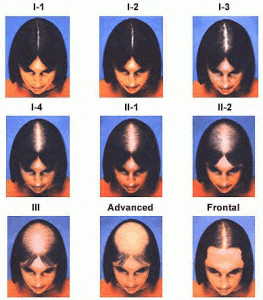Female Pattern Hair Loss
If you are a woman experiencing shedding or thinning hair, you are in the company of an estimated 20 million American women who also suffer from hair loss. Unfortunately, many women mistakenly believe they are the only female with this condition because it is a common misconception that hair loss is something that only happens to men.
Ludwig Scale

Savin Scale

While women typically experience a somewhat different hair loss pattern than men, the onset of hair loss in both sexes can occur anytime after the teenage years. Because of the effect of hormones, for some women, hair loss can become more evident:
- When starting birth control
- After the birth of a child
- Around menopause
- When starting hormone replacement therapy
- After a total hysterectomy
While female hair loss can present in many ways, the most common types of hair loss in women are:
- Diffuse hair loss, in which hair loss is evident all over the top or crown of the scalp, resulting in decreased hair density, coverage and volume
- A slight recession of the hairline, and/or
- Loss of density and coverage at the frontal half of the scalp–starting just behind the hairline and extending toward the crown.
In most cases, unlike male pattern baldness, hereditary hair loss in females does not typically result in a total balding of the affected area.
Treatment of Female Pattern Hair Loss
Because medical research has yet to identify the specific trigger for female pattern hair loss, there is no one particular treatment option that is the ‘magic bullet.’ While most women are looking for the ‘miracle cure,’ unfortunately the answer for the vast majority of hair loss sufferers will be a multi-therapy approach. A “multi-therapy” approach, like the one advocated by Dr. Bauman, uses a combination of available technologies that have been shown to have positive results for patients. Just like the classic combination of ‘diet and exercise’ for weight control and general health, most often it is a combination of various treatments that yield the best results.
A complete medical history, hair loss history, scalp exam (with and without a microscope), laboratory tests, etc. may be required to ‘get to the root’ of your hair loss problem. Dr. Bauman may then recommend one, two, or more various therapies designed to maintain and enhance the hair you have as well as restore the hair you may have lost. A multi-therapy regimen may include nutritional supplementation, medications, laser therapy, PRP, specific haircare products or regimens, and/or hair transplantation. For some, a non-invasive approach will be worthwhile and for others, transplantation may need to be added to the regimen.
Note: Without exception, ALL non-invasive treatments will need to be continued in order to maintain the results you achieve. Discontinuing a non-invasive hair restoration treatment will likely lead to a regression (loss) of results. How quickly the ‘results’ are lost varies depending on a variety of factors including the severity of the hair loss process and the specific treatments being discontinued. For more information on what combination of treatments may be right for you, contact Dr. Bauman for an online or in-person consultation.
